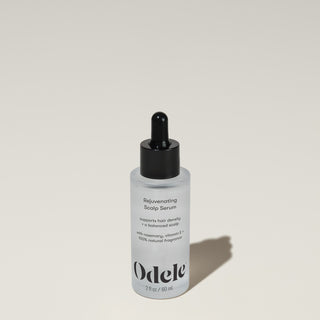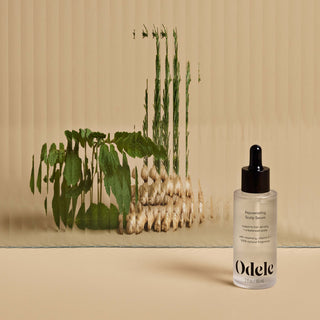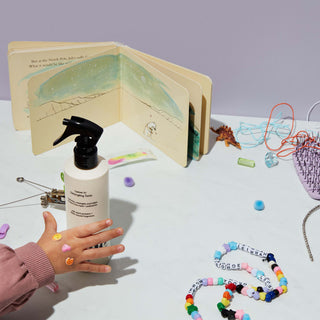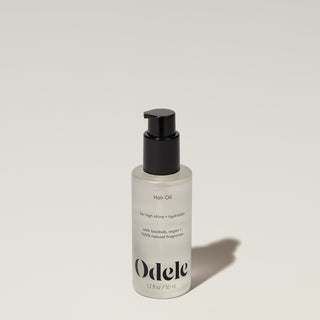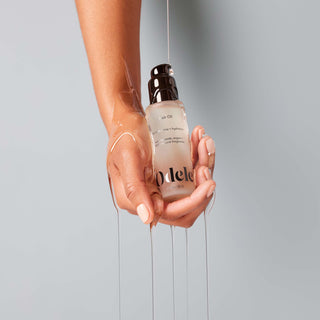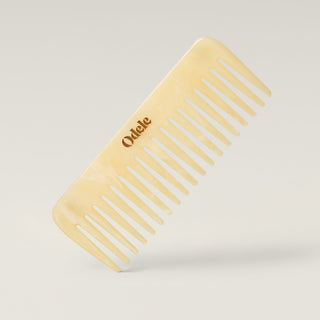If you’ve ever been told to brush your hair 100 strokes a day, you can let that one go—it’s a myth with serious split-end potential.
The truth? There’s no magic number. How often you should brush or comb depends on your hair type, texture and what you’re working with day-to-day. Because while brushing and combing might seem simple, the right approach can make a big difference in shine, strength and overall hair health.
Let’s brush up on what these habits actually do for your strands—and how to make the most of them.
What are the benefits of brushing your hair?
Brushing does more than make your hair look polished; it keeps your scalp and strands in balance.
-
Distributes natural oils. Each stroke helps carry sebum (your scalp’s natural conditioner) from root to tip, adding shine and softness.
-
Detangles and smooths. Gentle brushing can loosen knots—especially in straight, wavy or thick hair—and help prevent matting.
-
Removes loose hair. It’s totally normal to shed between 50 and 100 strands a day. Brushing helps release and collect those loose hairs so they don’t tangle or accumulate at your roots.
-
Boosts circulation. The light friction from brushing stimulates blood flow at the scalp, which supports a healthy environment for growth.
-
Reduces static and frizz. Regular brushing helps realign the cuticle layer, leaving hair smoother and shinier.
-
Supports scalp health. By lifting away dust, residue and buildup, brushing can help keep follicles clear and balanced.
What are the benefits of combing your hair?
Combing is all about precision and control—detangling, sectioning and evenly distributing product where your hair needs it most.
-
Gentler detangling. Wide-tooth combs glide through hair with less friction than most brushes.
-
Distributes conditioner and product evenly. Running a comb through damp hair helps spread moisture and treatments from root to tip.
-
Defines texture. For curls and coils, combing your hair while it’s saturated in a conditioning product helps separate and define strands without frizz.
-
Prevents breakage. Combing gently (especially from the ends up) helps remove knots without putting stress on your scalp or stretching wet strands.
-
Helps with styling. Fine-tooth combs make clean parts, slick ponytails and smooth finishes easy.

How often to brush or comb your hair (by hair type)
Straight or wavy hair
Brush once or twice a day—morning to refresh and distribute oils, evening to smooth things out. Comb as needed for styling or gentle detangling. Over-brushing may overstimulate oil production, so gentle and minimal is best.
Curly or coily hair
Skip daily brushing. Over-brushing can disrupt your curl pattern and cause frizz. Detangle with a wide-tooth comb or your fingers only when hair is wet and coated with conditioner to minimize breakage and preserve definition.
Fine or fragile hair
Brush lightly once a day or every other day to distribute oils and reduce tangles. Use a wide-tooth comb for gentle detangling, starting from the ends and working upward to avoid snapping strands. Choose a soft, flexible bristle brush to minimize tension and damage.
Thick or textured hair
Brush occasionally, mainly to smooth or stretch styles. Detangle every few days or as needed, especially before washing. Wide-tooth combs, detangling brushes or your fingers work best when hair is wet and conditioned.
Signs you might be overdoing it
If you’re seeing any of these signs, your hair might be telling you to ease up.
-
More breakage or split ends. Tiny broken strands on your clothes or constant split ends could mean you’re brushing too roughly or too often.
-
Frizz instead of smoothness. Frizz is often a sign that your hair needs more moisture. Try brushing after applying a leave-in or a few drops of Hair Oil to help reduce friction and smooth the cuticle.
-
A sore or sensitive scalp. Brushing should feel like a massage, not a scratch. Too much pressure or stiff bristles can irritate the scalp and even cause micro-abrasions.
Tips for healthier brushing and combing
-
Work in sections. Detangling smaller sections gives you more control and helps you work through knots without pulling on the rest of your hair.
-
Start from the ends. Brushing or combing from the bottom up lets you gently loosen tangles instead of dragging them downward. Starting at the roots can push knots tighter and cause snapping or breakage along the way.
-
Add slip. If your brush feels like it’s catching, your hair probably needs more moisture or lubrication. Use a product like our Leave-in Detangling Tonic to help tease out tangles.
-
Keep your tools clean. Buildup can collect on brushes and combs. Wash them every now and then to keep your hair and scalp clean.
-
Listen to your hair. If your scalp feels sore, your ends look frayed or you’re shedding more than usual, ease up.

Support your routine
Pair your brushing and combing habits with a healthy hair and scalp care routine:
-
Clarifying Shampoo: resets your scalp and removes buildup
-
Rejuvenating Scalp Serum: nourishes and balances between washes
-
Leave-in Detangling Tonic: adds slip and moisture to make detangling easier
-
Hair Oil: smooths frizz, seals ends and adds shine
Brushing and combing FAQs
Is it bad to brush your hair when it’s wet?
Not if you use the right tool. Wet hair is more fragile and prone to stretching or snapping, so use a wide-tooth comb and start from the ends.
How often should you brush curly hair?
Most curly and coily hair types only need detangling once or twice a week, always when wet and conditioned. Brushing dry curls can cause frizz and break up your curl pattern.
Should you brush your hair before washing it?
Yes, gently. Brushing or combing before shampooing helps detangle your hair so the cleanser can work more effectively—and prevents knots from tightening once your hair’s wet. Washing tangled hair can cause breakage, so taking a minute to detangle first makes for a smoother (and healthier) wash.
Can brushing help hair grow?
Not directly, but brushing promotes circulation to the scalp and distributes oils that support a healthy environment for growth.
Is it better to use a brush or a comb?
It depends on your hair type and what you’re doing. Brushes are best for distributing oils and smoothing dry hair, while combs (especially wide-tooth) are ideal for detangling wet or curly hair.
What’s the best brush for my hair type?
We put together a whole guide on this! Ultimately, the right brush depends on your texture and what you’re trying to do, but here are some quick tips:
-
Fine or straight hair: Look for soft, flexible bristles or a boar bristle brush to gently distribute oils and add shine without pulling.
-
Thick or wavy hair: A cushioned paddle brush or one with mixed bristles helps smooth while keeping volume and movement.
-
Curly or coily hair: Stick with wide-tooth combs, detangling brushes, or even your fingers to preserve curl definition and minimize frizz.
Whatever your texture, the best brush is one that glides through your hair easily—no tugging, no tension.


